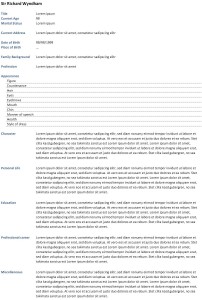Your novel features many characters. Each of them has individual characteristics of appearance and behaviour. You might easily remember the long dark hair of your heroine and the aquiline nose of your hero. But remembering every bit of information about every character is likely to be a challenge. It is advisable to list those attributes somehow.
List? I am a writer! Not an accountant.
That’s right, but order, lists and databases do not restrict you. They help you to get the best out of your data collection. There are some useful means that can spare your memory the pain of remembering hundreds of details.
This is the first of a series of three posts about keeping track of your characters and their attributes. It is about:
- The minimum information about your characters you should write down
- Details about your characters you should define – as it may be relevant for your writing
- Optional approaches for developing your character
In the second post, I will show you:
- How to store the various aspects of your characters
- Tools for handling the characters’ data
- Plus: a download of a FREE tool!
The third post will include:
- a sample and a quiz for experts of the Regency era
General Information and Characteristics
Minimum scope of information
Even memory athletes should, at the very least, write down first name, surname and title (if applicable) of every character. You will then just have to remember all other relevant aspects and should be able to picture each character very accurately.
It can be helpful to put down how the characters are related to each other. This is especially true for a Regency novel containing lords, heirs and complex family connections.
Extended scope of information
Writers will usually define not only the names, but also further characteristics of appearance. Here is an overview of information and aspects you may want to define for some or all of your characters.
General Information
- First name
- Surname
- Title
- Date and place of birth
- Current age
- Current address
- Marital status
- Family background/relationship to other characters of the novel
- Personal life
- Education
- Profession and career
- Religion
- …
Appearance and behaviour
- Figure
- Countenance
- Colour of hair and eyes
- Form of eyebrows, mouth and chin
- Style of dress
- Health
- Manner of speech
- Disposition/character
- …
A way to put down all this is shown here (click to enlarge):
Advisable scope of information
It is often recommended to write a biography for each main character. I also advise you to do this. It is a lot of work, but will make your characters more credible and easier to work with.
If you insist on reducing the preparatory work and skipping the biographies, you can use the interview technique to explore certain aspects or opinions of a character.
In the next post of this little series, I will tell you about useful tools for handling all the data. Please come back in a few days or subscribe to this blog using the “Subscribe to our free Newsletter”-form in the lower right corner to get notified about the next post.

